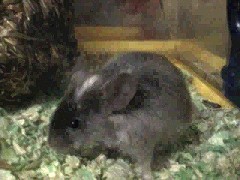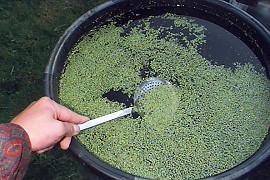|
 Mousetronaut Joystik prepares for her next feast. |
The CEMSS, a miniature bio-regenerative life support analog, will contain two female mice, and several trays of the aquatic plants lemna minor, (duckweed) and water fern, (azolla). This is an experimental analog of a hypothetical Martian Cave colony, and all environmental variables will be tracked and recorded during the length of a two-day experiment. This part of the project will investigate the feasibility of utilizing lava tube caves on Mars as possible habitats and resource locations for future human explorers.
The CEMSS and its cargo spent two days in Skylight Cave, a lava tube near the Central Oregon resort of Black Butte at the end of September, 2002. The Unit was placed on a scaffold, beneath one of three unique 'hornito' openings within Skylight Cave, a moderate sized lava tube cave. Power was provided via photovoltaic solar cells charging a bank of batteries, connected to the CEMSS by an umbilical cord going into the cave. On the surface, support equipment included a portable weather station and computer data logging equipment. Click Here to view the front page photos from the Bend, Oregon "Bulletin" daily newspaper.
 Duckweed harvesting operation. |
In the cave, the living duckweed and waterfern convert CO2-rich "mouse-breath" into breathable oxygen. A series of timed fans and vents insure a constant air flow. The CEMSS unit likewise includes a small thermoelectric cooler/heater that will provide a stable temperature for the two Mousetronauts.
Variables tracked included oxygen and carbon dioxide levels within the unit as well as temperature and relative humidity. The weather station recorded environmental conditions on the surface and within the cave itself. The CEMSS portion of the Mars Cave study is a precursor to a larger, human-scale experiment slated for the summer of 2003 in a cave in Arizona. Our first of several "Mouse Missions to Inner Space" is scheduled to begin its 48-hour run over the weekend of 27 September, 2002. In the following months, we will continue to run more extensive and lengthy trials of the CEMSS unit, culminating in a two-week mission sometime in the late winter or early spring of 2003.
Return to the Martian Caves Index
Copyright © 2002-04 - Complex Systems Research; Inc.
